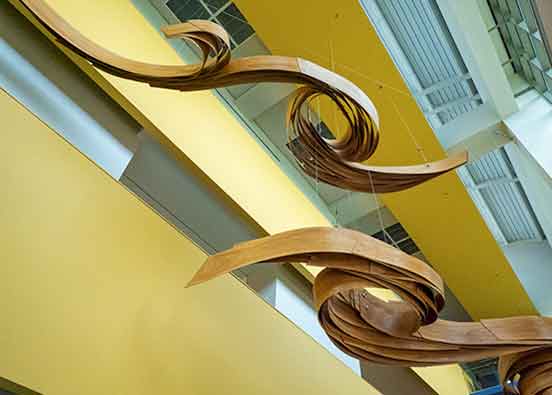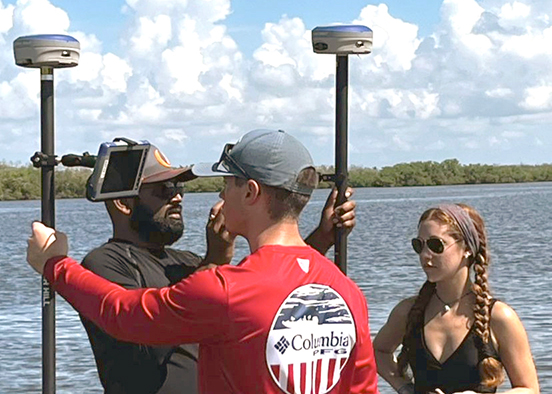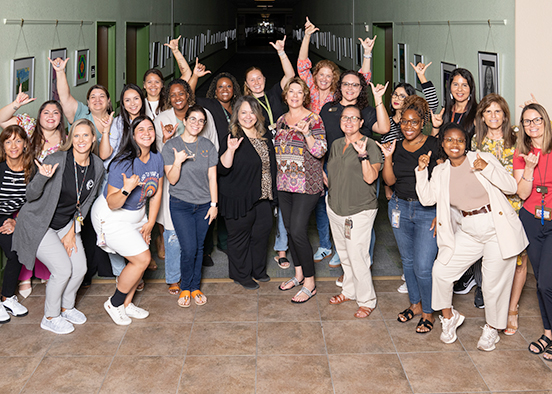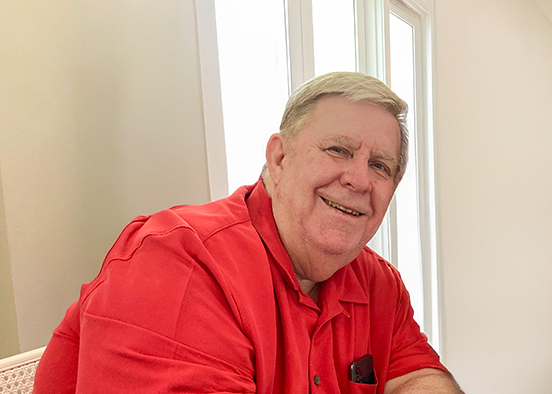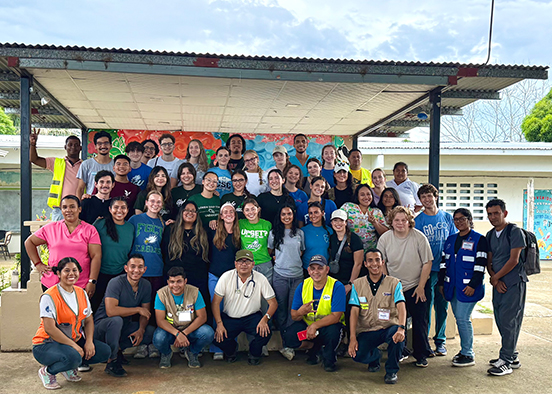10 public artworks that capture culture on campus
Public art, accessible to everyone regardless of background or experience, is created intentionally for display in communal spaces. It can take many forms: sculpture, murals, installations or mixed media. At Florida Gulf Coast University, public art is integrated into the environment. Some works are decorative, some are landmarks, some are purchased, some are donated — and all are points of pride.
You don’t have to be an art aficionado to enjoy this type of art. It invites everyone in and sparks thought and conversation. FGCU’s campus is open to the public during regular hours, and visitors can take a self-guided art walk. Wander the pathways between academic buildings, stop into the library or Arts Complex, hit up Alico Arena before a game or explore the green spaces in between. Each location holds its own artistic discovery.
Azul’s Flight Tour statues (various locations)
In 2015, five artists won the opportunity to produce their own creative visions of Azul through a contest sponsored by Student Government and the FGCU Foundation to foster school spirit by sculpting, gluing and painting on human-sized fiberglass replicas of FGCU’s winged mascot.
Roughly 6 feet 2 inches high and weighing about 150 pounds each, the six Azul’s Flight Tour statues now live at various locations on campus:
Andrew Corke’s “Never ‘Tired’ of Winning” Azul is displayed in the University Library.
Scott Guelcher designed two statues: “Graduation Azul” is in the Sugden Welcome Center and “Azul Flies Around The Bases” is at Alico Arena.
Diana Rochez’s “Dunk City Azul” is also at Alico Arena.
Colleen Solomon’s “We Bleed Green and Blue” Azul is in Marieb Hall.
Geoffrey Stephens’ “Peaces of The Nest” is on display in front of the bookstore in the Cohen Student Union.
If you want to see them: Plan out your statue scavenger hunt using the locations listed above and the interactive campus map.
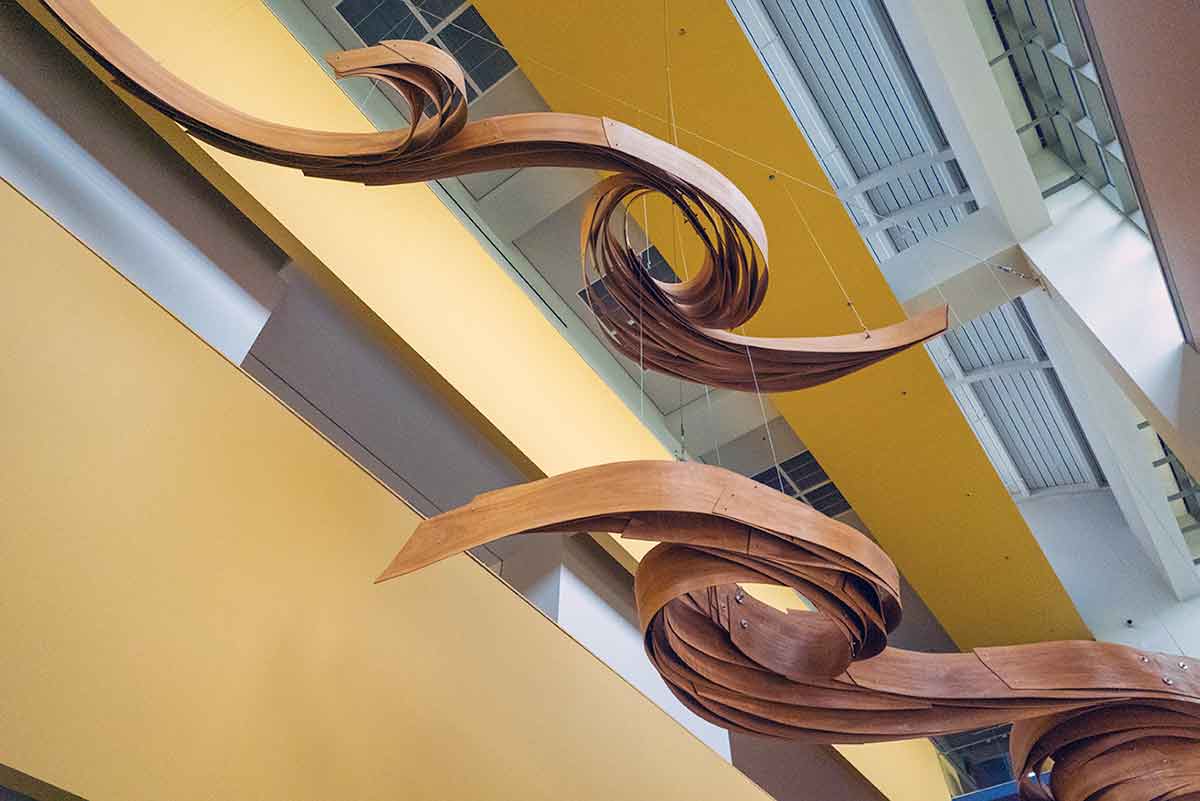
Ecotone by Barbara Cooper (University Library)
Rachel Cooke is the education and arts librarian in the University Library. Her favorite piece in the library is Ecotone by Barbara Cooper, a suspended sculpture located in the library’s central atrium near the elevator banks. The artwork features two forms, each about 25 feet long, crafted from layered cherry veneer and metal.
In creating the site-specific piece, Cooper envisioned the library as “a place where different areas of study meet, overlap and generate new ideas and energies beyond the confines of the individual disciplines that it supports.”
“It’s a fun piece to visit,” Cooke says. “The overwhelming scale of the sculpture, suspended from above, has a wonderful sense of movement and energy.”
Ecotone was commissioned as part of Florida’s Art in State Buildings Program, which requires that up to 0.5% of the construction budget, capped at $100,000, for new state-funded buildings be used to acquire permanent public artwork. Funding was provided by Florida’s Public Education Capital Outlay program. PECO is primarily funded by Florida’s Gross Receipts Tax on Utility Services and provides funding for capital projects in K-20 public education. Each eligible building at FGCU includes at least one PECO-funded installation.
If you want to see it: Cooke suggests viewing the sculpture from below, on the first floor of the library, as well as from eye-level and above it, on the second and third floors.
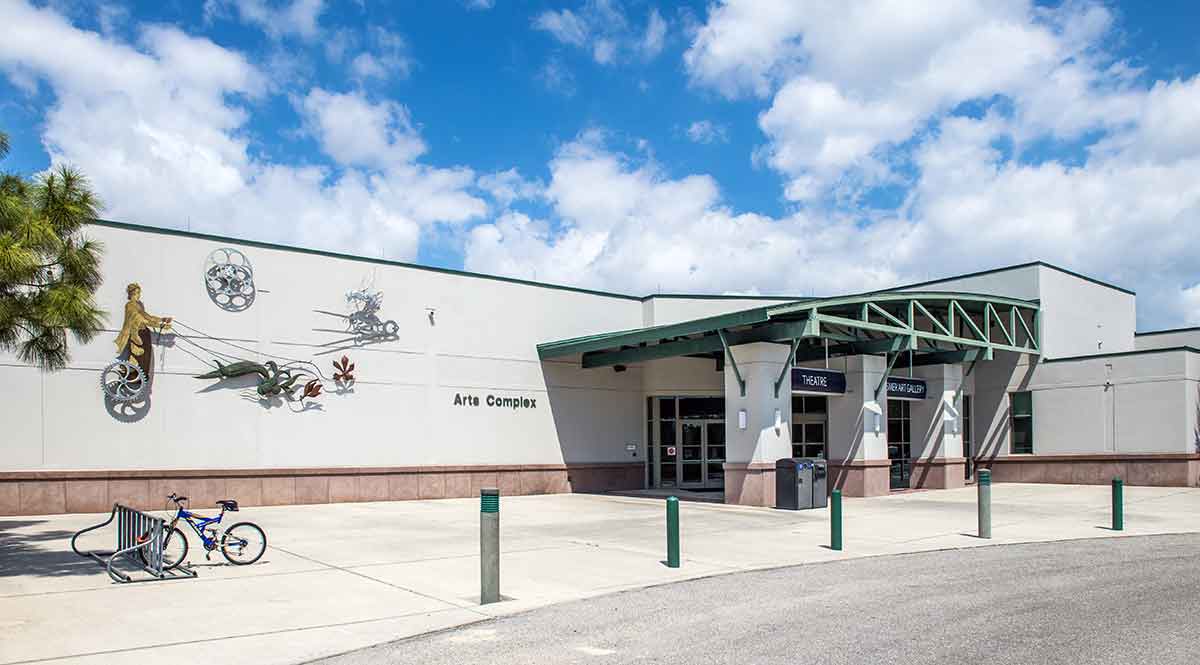
Dream to Connect by Mary Voytek (Arts Complex)
“Ecotone” is one of many pieces commissioned as part of Florida’s Art in State Buildings Program — a list can be found on the Facilities Planning website. Another such work is “Dream to Connect,” mounted on the facade of FGCU’s Arts Complex, which opened in 2002.
“Dream to Connect” is a mixed-media work by Mary Voytek, an associate professor of sculpture in FGCU’s Bower School of Music & the Arts. Anchored by Apollo in a gear-shaped chariot, the piece features a silver dollar orchid, a honeybee alighting on a compass and a film reel — all arranged in a circular composition. Crafted from brass, titanium, copper and aluminum, and illuminated, the sculpture connects classical ideals with contemporary materials, reflecting FGCU’s environmental mission, the role Florida’s natural wonders play in attracting visitors to the state, and the interrelation of educational programs at the university.
“There’s interconnectedness at a university and an intellectual pursuit. I wanted the piece to speak to that wonderful dream of connecting things that are often separated,” Voytek says.
“We have some amazing pieces all across campus. I think it would be wonderful to come on a little treasure hunt,” she says. She suggests visitors explore the public art before or after attending a gallery show or theatre, music or sports events on campus.
“It enriches a university campus to have these public art works in different locations. It’s a nice surprise. You turn the corner and come upon something unique.”
If you want to see it: Head to the Arts Complex — you’ll find the piece affixed outside the main entrance. And while you’re there, check out the FGCU Art Galleries, which host up to 10 exhibitions a year showcasing student, regional and national artists.
Untitled by Dennis Gallagher and Heart and Soul by Paul Firmin (walkway between the Arts Complex and the Library)
The untitled Dennis Gallagher ceramic sculpture at the other end of the Arts Complex outside the courtyard is a piece from the FGCU Art Galleries’ permanent collection, gifted by Christine and Bob Dickemper. Their donation inspired the idea of starting a sculpture garden outside the Arts Complex.
Gallagher, a San Francisco sculptor known for his work in ceramic media, died in 2009. The piece is made of ceramic and is in two parts with a steel rod supporting both pieces. Gallagher made the piece in 1991, and the Dickempers donated it to FGCU in 2024.
“The work is figurative but there is no specificity of gender, age or ethnicity,” says John Loscuito, director of the FGCU Art Galleries. “This artwork bridges the gap between abstraction and representation in a beautiful way both in its surface and overall form. I believe it is open to interpretation on many levels and hope that it inspires our students in the studio.”
Free and open to the public when the university is open, FGCU’s galleries display works of art by students, alumni, faculty and professional contemporary artists. Display spaces include the Wasmer Art Gallery and the third floor exhibition space in the library. Outside the north end of the Arts Complex, visitors will also find “Heart and Soul,” a mural by art alum Paul Firmin, which was selected for the second annual Public Art Project and remains through October.
If you want to see it: Park in Garage 2 and walk towards the Arts Complex. You’ll find the piece along the walkway between the Arts Complex and the library.
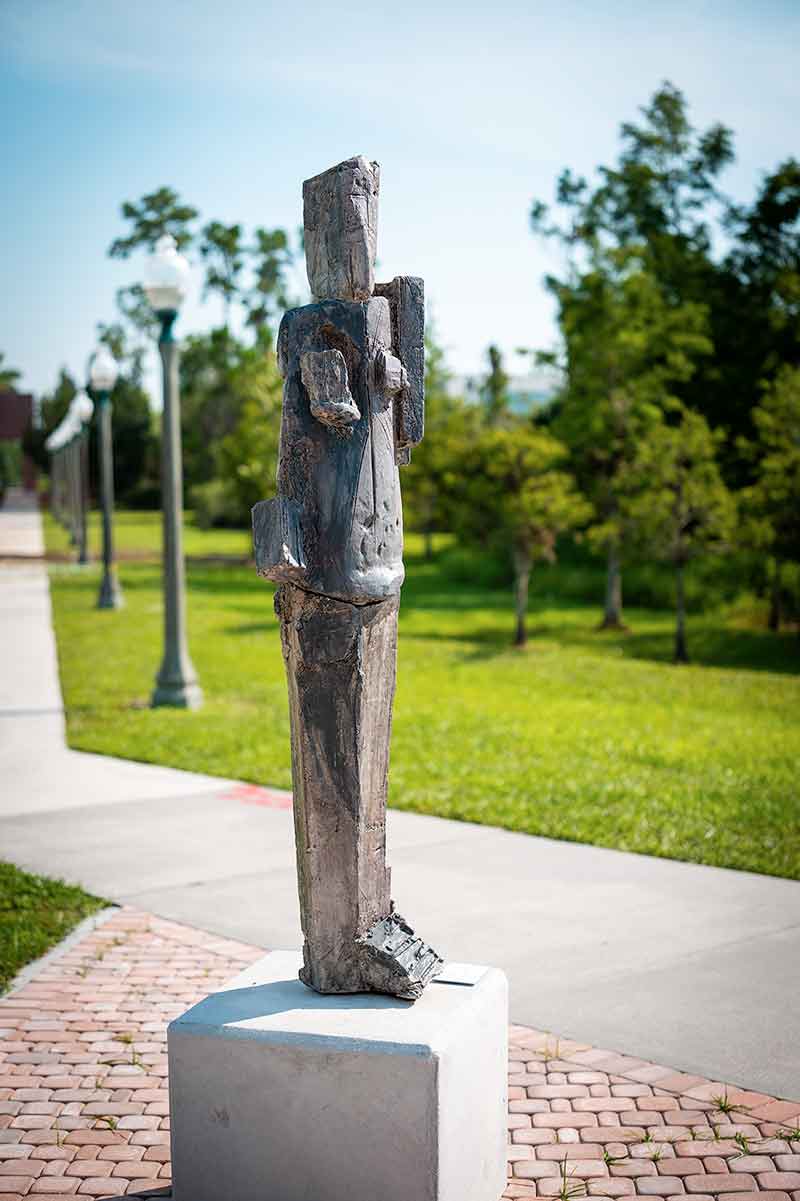
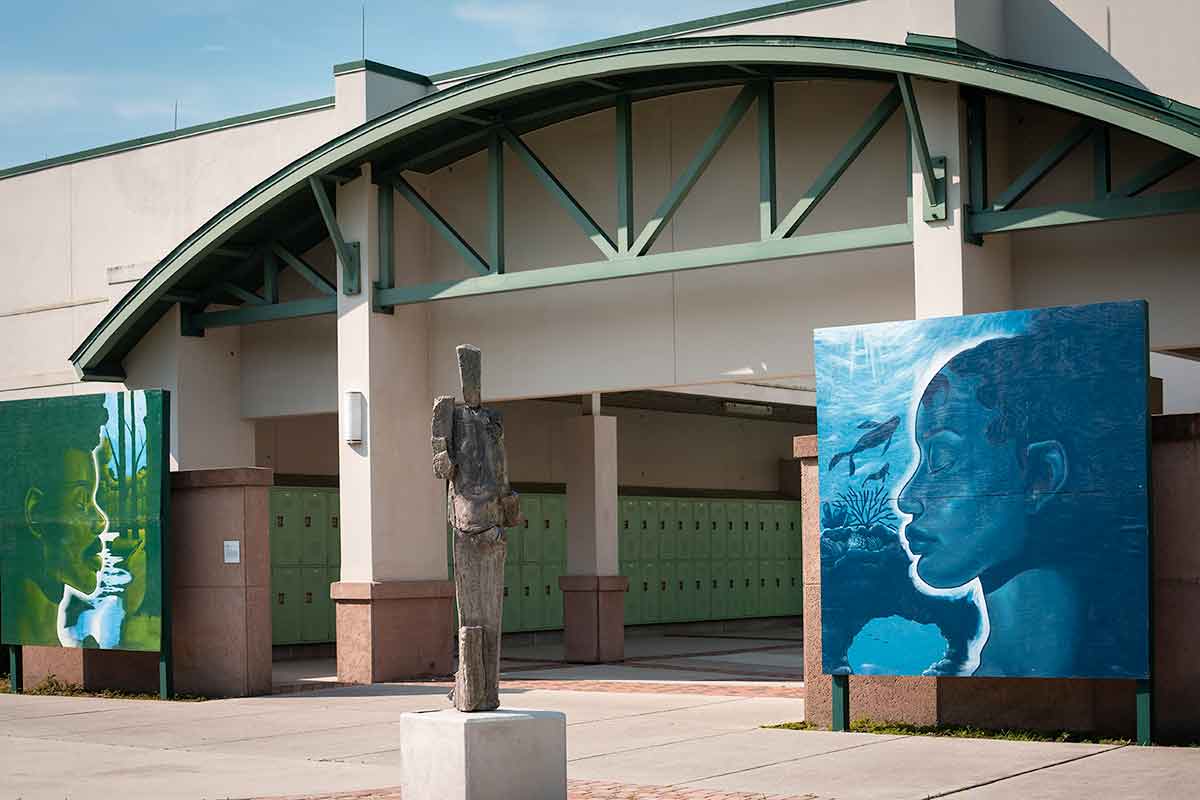
Come spark your imagination on FGCU’s campus
FGCU’s public art tells the story of a university rooted in creativity, community and a deep respect for place. These works invite us to pause, reflect and see the campus through a lens that values artistic expression as a vital part of learning and living. Everyone from first-time visitors to students rushing to class and lifelong art lovers can come be part of the nature and culture FGCU has preserved and cultivated.
This article is first in a series highlighting FGCU’s distinctive campus.
Latest FGCU News
- From stealing bases to studying forensics, softball star sets the paceTo understand the impact Dave Deiros had in 24 years as Florida Gulf Coast University’s head softball coach, you have to go beyond the numbers...
- FGCU students harness technology to study hurricane impacts, coastal habitatsIt isn’t easy being James Evans these days. As chief executive officer of the Sanibel-Captiva Conservation Foundation, Evans is responsible...
- FGCU grads stepping up amid school counselor shortagesThe first four students to graduate from medical school through Florida Gulf Coast University’s pre-health professional program partnership with Lake Erie College of Osteopathic Medicine (LECOM) are...
- From internship to career to mentor, alum at Arthrex comes full circleEmily might be in Paris on Netflix, but a new internship opportunity unique to Florida Gulf Coast University enabled two...
- $800,000 gift honors longtime friend and fan of FGCUDaniel Schroeder might be the ultimate Southwest Florida resident. Born and raised in the area, he is a Florida Gulf Coast University alum with...
- Students get hands-on healthcare experiences on a global scaleThe first four students to graduate from medical school through Florida Gulf Coast University’s pre-health professional program partnership with Lake Erie College of Osteopathic Medicine (LECOM) are...



